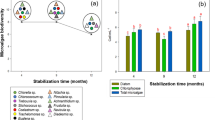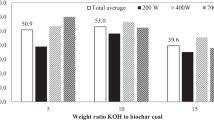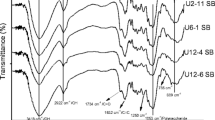Abstract
When wetlands reach maximum treatment capacity to remove heavy metals, removal can still take place through precipitation as sulfide because of the biological reduction of sulfate. To achieve this goal, anaerobic conditions must be attained, a sulfate source must exist, and an adequate substrate for sulfate-reducing bacteria (SRB) is also required. In the present work, two ligneous-cellulosic materials, a brown seaweed and sugarcane bagasse, have been selected as substrates for SRB growth. Experiments were simultaneously conducted in continuous operation in two columns (0.57 L each), one containing the ligneous-cellulosic material plus inoculum and another containing only the ligneous-cellulosic material. In this work, the removal of cadmium and zinc was studied because of their presence in effluents from mining/metallurgy operations. Results obtained indicated that the inoculated reactor was able to treat the effluent more efficiently than the noninoculated reactor considering the time course of the tests.
Similar content being viewed by others
Explore related subjects
Discover the latest articles, news and stories from top researchers in related subjects.Avoid common mistakes on your manuscript.
Introduction
During the treatment of heavy-metal containing solutions, the use of constructed wetlands is thought of as an easy technological alternative when compared with conventional treatment methods. The term wetland is used to characterize natural ecosystems partially or totally flooded during the year. Observations about the ability of natural wetlands to change the quality of water led to the development of artificial ecosystems able to treat several classes of wastewater. Those ecosystems are called constructed wetlands, and the main processes involved in the treatment of metals include adsorption by soil or sediment fractions, complexation by organic matter, plant uptake, and precipitation as carbonate or sulfide [1].
Several published reports on both natural and constructed wetlands affirm that metal removal from wastewater will continue indefinitely through the production of biogenic sulfides by sulfate-reducing bacteria (SRB) followed by precipitation. These microorganisms are responsible for sulfide production as long as sulfate is present in the influent and an organic substrate is provided [1–3]. Various organic wastes have been used as substrate for SRB such as wood dust [4], hay and straw [5], oak chips and sludge from a wastepaper recycling plant [6], and spent mushroom compost [7]. In these cases, these solid waste materials were able to sustain SRB growth for long periods without the addition of other substrates. According to Chang et al. [6], first the polysaccharide from waste material seems to be degraded by hydrolytic fermentative anaerobes to fatty acids and alcohols that support the growth of sulfidogens.
The objective of the present work was to evaluate the use of two ligneous-cellulosic materials, a brown seaweed and sugarcane bagasse, as substrates for SRB growth and to investigate their ability to remove heavy metals simulating constructed wetlands.
Materials and Methods
The experimental setup used in the study is comprised of one reservoir (10 L), from where the solution is fed, through peristaltic pumps, into two column reactors (0.57 L). Experiments were simultaneously conducted in both columns. The first one (column A) contained 40 g of ligneous-cellulosic material plus inoculum, and the second column (column B) contained just 40 g of ligneous-cellulosic material. The anaerobic sludge used as inoculum was obtained from the bottom of an upward-flow anaerobic sludge blanket (UASB) reactor from the effluent of a poultry-processing plant.
The influent composition was defined so as to simulate drainage wastewater from a metallurgical industry dam. Thus, the composition of this synthetic wastewater presented around 80 mg/L zinc, 2 mg/L cadmium, and 800 mg/L sulfate. Table 1 summarizes the main operational characteristics of the experimental runs investigated at 25 ± 2 °C.
Influent and effluent sampling was undertaken twice a week from both columns, filtered through 0.45-μm filters, to measure chemical oxygen demand (COD), sulfate, and metals concentrations. At the end of each experiment, samples of the biomass were collected, and total solids (TS), volatile solids (VS), and SRB population were determined.
Sulfate, COD, TS, and VS determinations were performed according to standard methods [8]. Soluble cadmium and zinc concentrations were determined by atomic absorption spectrophotometry (Perkin-Elmer AAnalyst 300). The SRB were enumerated by the most probable number (MPN) technique (n = 3), utilizing Postgate B semisolid medium [9]. Inoculated tubes were incubated at 35 °C for 28 days. The growth of SRB was indicated by the formation of a black FeS precipitate.
Results and Discussion
Consumption of Organic Matter
To evaluate the process of metal removal in relation to the consumption of organic matter, COD was measured in the effluent of columns A and B (Fig. 1). The COD of the influent solution, for all the runs conducted, was always below the detection limit of the method (15.0 mg/L). This was expected to occur once there is not a significant amount of oxidizable matter or organic compound in the influent solution.
The results of COD determination for run I showed that although the first sampling occurred after 7 days of operation, COD values obtained in the noninoculated column (column B) presented small availability of organic matter for the inoculated sludge in column A. The average COD from the seventh day of run until the end of the run was equal to 22.2 mg/L in column A (inoculated) and 20.1 in column B, indicating that the availability or organic compounds to the bacteria was quite limited.
In Fig. 1, it can be observed that for some samples of run I (24th, 38th, and 52nd day), there was an increase in the COD value from the effluent from the inoculated column, probably because of the washout of particles from the inoculated sludge [10]. From the results presented in Fig. 1 for column B (noninoculated) during run II, it could be observed that because the organic material is more amenable to degradation, the available organic matter (as COD) was superior than previously observed (run I) for around 30 days. During this period, the difference between the COD measured in the effluent of the noninoculated column (column B) and the COD measured in the inoculated column (column A), corresponding to the organic matter used by the microbes, was around 92.0 mg/L, with a maximum value of 338.0 mg/L, in the first days of the experiment.
Bacterial Reduction of Sulfate Ions
The concentrations of sulfate ions in the influent to the reactors and effluent solutions from the columns are presented in Fig. 2. It could be observed that in all the runs performed, the concentration of sulfate in the effluent from column B (noninoculated) presented slightly higher values than the ones observed in the influent solution. This increase was probably due to the release of sulfate ions present in the structure of the seaweed. Thus, the amount of sulfate available for SRB cells corresponds to the amount of sulfate present in the influent of the columns plus the amount of sulfate released by the seaweed. Based on these considerations, it could be concluded that the reduction of sulfate actually happened in all the experimental runs conducted.
To better understand these results obtained for column A (inoculated), Fig. 3 presents the amount of sulfate reduced by the bacteria against time. This amount of sulfate ions was calculated as the difference between the sulfate-loading rates in column B (available to SRB) and column A (mg SO4 2−/L day).
It could be observed from these results that the biological reduction of sulfate obtained during run I did not show an adaptation period because of the fact that sulfate reduction was quantified from the seventh day of the run. The reduction of sulfate was followed up to the 21st day because of the availability of organic matter for metabolic processes.
A stoichiometric approach of the present sulfate reduction indicated that it would be necessary to have 140 mg SO4 2−/day, considering a hydraulic retention time equal to 16 h, to produce enough sulfide to remove all cadmium and zinc present in the effluent solution.
According to Chang et al. [6], when some ligneous cellulosic materials are used as the carbon source (such as hay or straw), the reduction of sulfate with further production of sulfide can be improved with the supplementation of electron donors easily accessible by the microbes, such as sucrose, peptone, and lactate. This can explain the marked increase in the efficiency of metal removal observed in run II, where seaweed was mixed with a certain quantity of sugarcane bagasse.
Removal of Cadmium
Figure 4 shows the inlet and outlet cadmium concentrations obtained in both columns for runs I and II, as well as the local discharge limits. In run I, cadmium concentration was higher than the discharge limit (0.2 mg/L) from the 47th day of experiment in the column containing just the seaweed as the carbon source (0.43 mg/L). In column A, cadmium concentration was kept below the 0.2-mg/L limit during the entire course of the experiment because of the inoculation of the system. The average cadmium removal observed was equal to 99.5% in the inoculated column, while in the noninoculated column, it was equal to 97.2%.
During run II, where column A also contained anaerobic sludge, the increase in the availability of organic matter to the microbial population because of the addition of sugarcane bagasse confirmed the importance of the inoculation of SRB in the system. The concentration of cadmium was higher than 0.2 mg/L from the 39th day on, in the column containing only the mixed carbon sources, seaweed and sugarcane bagasse, reaching the value of 0.32 mg/L. On the other hand, the concentration of cadmium in the inoculated column was below 0.2 mg/L over the entire experiment. The average removal of cadmium in the columns was around 97.0% in the inoculated column and around 74.0% in the noninoculated column.
Removal of Zinc
In Fig. 5, the analytical results for zinc in the influent and effluent solutions is presented, as well as the local discharge limit for this metal (5.0 mg/L). During run I, zinc concentration was higher than the discharge limit, from the 21st day (9.8 mg/L) in the noninoculated column (B) and from the 28th day (6.5 mg/L) in the column inoculated (A) with anaerobic sludge. The average removal of zinc observed was equal to 86.4% in the inoculated column and 49.6% in the column containing the seaweed only.
The increase in the availability of organic matter proved to be efficient in the removal of zinc during run II. In this run, zinc concentration was higher than the discharge limit (5.0 mg/L) from the 11th day (10.6 mg/L) in the column B and from the 56th day in the column A (6.9 mg/L). The average metal removal in the columns was equal to 94.4% in the inoculated and 32.6% in the column containing the seaweed and sugarcane bagasse only.
Beyond the biological process of sulfate reduction with subsequent metal precipitation as sulfides, other mechanisms of metal removal can be present during the runs, particularly in the inoculated column (A): precipitation as metals carbonates using the bicarbonate and/or carbonates formed during the reduction of sulfate by the SRB cells or by fermentation from other microorganisms, precipitation as metal hydroxides, complexing with substances excreted by the cells, and accumulation on the surface of cells, through reactions between metal ions and cell wall components [10].
Among those mechanisms, the most probable involved other than precipitation as sulfides are precipitation as metal carbonates and accumulation on the surface of the cell. This last one is due to the interaction of negative charges from biopolymers present on the outer structure of the cells and metal ions present in the solution [11].
Quantification of SRB Cells Present in the Sludge
The number of SRB cells was determined before and after each run performed. The results are presented in Fig. 6.
At the end of the experiment of run I, two distinct types of sludge could be individually identified based on color. Much of the total sludge was black, and a small part of the sludge was present as a gray precipitate, probably because of a higher concentration of zinc sulfide, a white precipitate. Because of this, the population of SRB cells in both types of sludge was quantified and also quantified in the inoculum. It could be noted that there was an 18-fold increase in the number of SRB cells present in the final black precipitate (19.0 × 106 cells/g VS) when compared to the inoculum (0.76 × 106 cells/g VS). However, in the final gray precipitate, the concentration of SRB slightly decreased because of an intense precipitation of ZnS. It is probable that the formation of this precipitate has contributed to decrease the activity of SRB cells, as observed in the study for the removal of metals in an UASB reactor using molasses and stillage as carbon sources for SRB [10].
During run II, an intense proliferation of photosynthetic microbes was observed in the reactors because of marked sunlight irradiation on the reactors. The number of SRB present in the final sludge (8.6 × 105 cells/g VS) was twice the number of cells in the inoculum (4.5 × 105 cells/g VS), although this increase was not remarkable. This fact can be related to the problems found in separating the final sludge from the remaining substrates (sugarcane bagasse and seaweed) still present in the reactors. Thus, those materials were considered in the determination of VS, consequently reducing the enumeration of cells/g VS. It is probable that the number of SRB cells present in the final sludge is actually higher than the value reported.
Conclusions
The following are the conclusions for the study:
-
The biological activity of SRB cells contributed to the process of precipitation of Cd and Zn, as compared to the noninoculated reactor, where physico-chemical mechanisms predominated.
-
For run I (seaweed only), in the noninoculated column (B), Cd removal was high, but Zn removal was not so good. In this case, the predominating mechanism was biosorption of metals. On the other hand, in the inoculated column (A), both Cd and Zn removals were very high, confirming the importance of the production of sulfides by SRB cells.
-
For run II (seaweed plus bagasse), in the noninoculated column (B), Cd and Zn removals were smaller than those obtained in run I. This was due to the presence of bagasse, which is not a suitable biosorbent material as the seaweed. On the other hand, in the inoculated column (A), both metals were efficiently precipitated as metal sulfides.
-
The reduction of sulfate in run II was improved with the mixture of seaweed and bagasse as carbon sources, reflected in higher precipitation of Cd and Zn, as compared to run I.
-
Although the production of sulfide was not enough to precipitate all zinc and cadmium present in the influent, other mechanisms also acted to improve the treatment process.
-
In both runs, there was an increase in the MPN of SRB/g VS in the final sludge, in comparison to the inoculated sludge.
References
Lorion, R. (2001). Constructed wetlands: Passive systems for wastewater treatment. Available at: http://clu-in.org.
Sobolewski, A. (1996). Ecological Engineering, 6, 259–271.
Hammack, R. W., Edenborn, H. M., & Dvorak, D. H. (1994). Water Research, 28, 2321–2329.
Tutle, J. H., Dugan, P. R., & Randles, C. I. (1969). Applied Microbiology, 17, 297–302.
Béchard, G., Yamazaki, H., Gould, W. D., & Bédard, P. (1994). Journal of Environmental Quality, 23, 111–116.
Chang, I. S., Shin, P. K., & Kim, B. H. (2000). Water Research, 34, 1269–1277.
Dvorak, D. H., Hedin, R. S., Edenborn, H. M., & Mcintire, P. E. (1992). Biotechnology and Bioengineering, 40, 609–616.
American Public Health Association (1998). Standard methods for the examination of water and wastewater (20nd ed.). Washington: APHA.
Postgate, J. R. (1984). The Sulphate-reducing Bacteria (2nd ed.). Cambridge: Cambridge University Press.
Gonçalves, M. M. M. (2001). D.Sc. thesis, Federal University of Rio de Janeiro, Rio de Janeiro, Brazil.
Gomes, N. C. M., Hagler, L. C. S. M., & Savvaidis, I. (1998). Revista de Microbiologia, 29, 85–92.
Acknowledgments
The authors would like to thank Conselho Nacional de Desenvolvimento Científico e Tecnológico (CNPq) and Fundação Carlos Chagas Filho de Amparo à Pesquisa do Estado do Rio de Janeiro (FAPERJ) for financial support to conduct this research.
Author information
Authors and Affiliations
Corresponding author
Rights and permissions
About this article
Cite this article
Gonçalves, M.M.M., de Oliveira Mello, L.A. & da Costa, A.C.A. The Use of Seaweed and Sugarcane Bagasse for the Biological Treatment of Metal-contaminated Waters Under Sulfate-reducing Conditions. Appl Biochem Biotechnol 147, 97–105 (2008). https://doi.org/10.1007/s12010-007-8091-1
Received:
Accepted:
Published:
Issue Date:
DOI: https://doi.org/10.1007/s12010-007-8091-1










